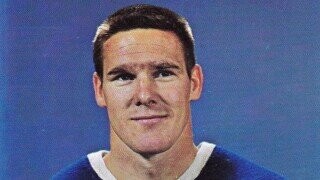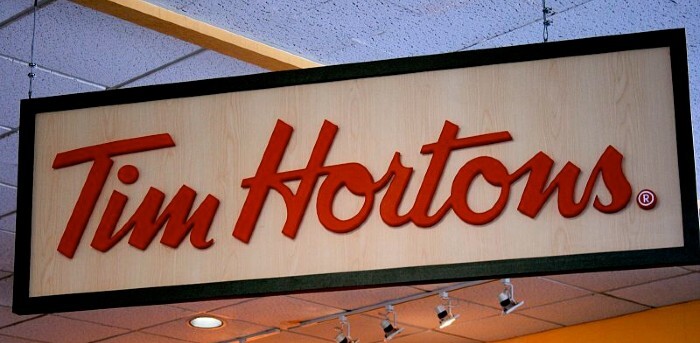Hockey and Doughnuts: The Extremely Canadian Life of Tim Horton

Tim Horton is as Canadian as Kids in the Hall and silly police uniforms. In fact, he may have single handedly altered the health and mortality of a nation (more on that later), but few non-hockey fans and even some Canadians even know who he is (that, too).
That Famous Name (Isn’t His)

Tim Horton was actually born Miles Gilbert Horton, named by his father after both of his grandfathers, but his mother had wanted to name him Tim, so she decided to just do it anyway. Not to make assumptions about the Hortons’ marriage, but it sounds tense.
He Was an Instant Legend (Literally)

Horton was recruited by the NHL straight out of high school, and it didn’t take long for legends to spring up around the guy who would become known as the strongest man in the game. Teammates told stories of witnessing Horton throw railroad ties “like they were toothpicks” or single handedly block an intersection with cement barrels as a prank, and one even insisted Horton could lift a 40-gallon oil drum over his head even though he’d never actually seen him do it.
The Horton Bear Hug
Despite his impressive physical prowess, or perhaps because of it, Horton wasn’t known to throw down like some of hockey’s more volatile players. His opponents rarely started shit with him because of his reputation as a strongman, but when they did, he wrapped them in what became known as the “Horton bear hug,” though it wasn’t always as nice as it sounds. One opponent recalled, "I heard my ribs groan and thought they were all going to crack. It really started to hurt, and then he let go and tossed me on my back like a towel. I never slashed him or challenged him again."
He Was the Epitome of Canadian Nice
That wasn’t the only way Horton was a gentle giant. On the road, he always made sure to say goodnight to his teammate, Dave Keon, to the point of breaking down the hotel door after Keon had locked it one night. Keon might not have appreciated it, and certainly, the hotel didn’t, but no one was stopping Horton from minding his manners.
He Had Terrible Eyesight

Seeing as how hockey requires following a tiny puck around on the ice and that’s it, that’s the whole game, it’s even more impressive that Horton was as good as he was despite being hilariously nearsighted. When he wasn’t playing, he wore such thick-framed glasses that his teammates nicknamed him “Clark Kent.”
He Owned a Car Dealership First

Beyond hockey and, like, family or whatever, Horton seemed to love two things: cars and doughnuts. He never actually retired, playing hockey well into his forties until literally the day he died, but you never know when an injury is going to take you out, so he opened a series of businesses in the ‘60s, the first of which were a car dealership and a gas station. After deciding food was where it was at, he opened a chain of burger restaurants that failed because he was ignoring his true love: fried dough. After Tim Hortons became a success, he recalled “this big, beautiful doughnut shop” outside Pittsburgh that he always visited when he was in town to see his wife’s family. “I had never really thought of being anything else but a hockey player before, but the first day I walked into that shop, I thought that I would really like to own my own doughnut shop someday.”
In a Different World, We’re All Eating at Jim Charades
As luck would have it, Horton met Jim Charade, who owned a doughnut shop on the same street as Horton’s barber. Charade was sure that putting a celebrity name on his struggling doughnut shop was just what it needed to rise to the top of the cutthroat yeasted dessert business, and it’s hard to say he was wrong. They opened the first Tim Hortons on May 17, 1964.
He Put His Doughnuts Where His Mouth Was

Horton wasn’t just the enthusiastic face of Canadian doughnuts -- he was also an innovator. The original Tim Hortons menu consisted of only two doughnuts of Horton’s own creation, the apple fritter and the dutchie. Despite what die-hard fans might insist, he probably didn’t actually invent these doughnuts, but the company definitely perfected them.
The Car He Crashed Was Part of His Contract

By 1971, Horton was, by his own admission, a “tired old man” and wanted to quit playing hockey, but after being offered the largest salary ever paid by his team, he decided to keep going to fund his doughnut business. It wasn’t a great season, resulting in ankle and shoulder injuries that left Horton with a bottle-of-scotch-a-day habit, but he was lured back to the ice by an even bigger salary … and a sports car. Even if you haven’t had the man’s life story drilled into you since birth, you probably see where this is going.
His Tragic Death

On February 20, 1974, after losing the game he played that night, Horton drove to corporate headquarters, where he and his business partner, Ron Joyce, drank into the hours that shouldn’t legally exist. Both Joyce and Horton’s brother, who he’d called at some point, advised him against driving, but he sped off around four a.m. at more than 100 miles per hour down the highway. A cop actually clocked him at some point, but he was going so fast that the officer lost him. Eventually, he lost control of his car, flipped it, and died shortly after arriving at the local hospital.
Officials Protected His Legacy
Horton is so revered in Canada that officials refused to confirm for decades that he was driving drunk when he died. It wasn’t until 2005, when an Ottawa newspaper got their hands on his autopsy report, that the public found out his blood alcohol level was twice the legal limit.
Tim Hortons is No Longer Tim Horton’s, Grammatically Speaking

A little drunk driving isn’t enough to wrest a guy’s restaurant out of his hands in Canada, but the tension between English and French speakers is. In 1977, Quebec (you know, the French part) passed a law that all business signs must be in French, which doesn’t use the possessive apostrophe. Rather than running Tim Horton’s and a separate Donettes de Horton or something, they just changed the company name to Tim Hortons despite the implication of an untold number of hockey-playing ghosts.
Today, Some Don’t Know He Was a Person

Every few years, some uncultured Americans and even Canadians get duly shamed for admitting on Twitter, of all places, that they didn’t know Tim Horton was a guy and not just, like, some doughnut-ejecting abomination. In 2014, some fans got so fed up that they started a petition to get Horton’s pictures back in restaurants.
He Started a Doughnut Dynasty
In a sort of confectionary nuptial alliance, one of Ron Joyce’s sons married one of Tim Horton’s daughters, and the couple owns several Tim Hortons franchises. It’s the closest thing to a monarchy Canada has, actual monarchy notwithstanding.
He Turned Canada Into the Leading Global Doughnut Consumer

Largely thanks to Tim Hortons, Canadians eat more doughnuts per capita than any other country in the world. He might have died young, but he’s apparently taking everyone else down with him.
Top image: Ralston-Purina Company/Wikimedia Commons